Hip Dysplasia: Information and Tips for Clients

Hip dysplasia is one of the most common causes of lameness found in dogs. An inherited orthopedic disease, large-breed dogs show the highest incidence of being affected.
Symptoms
Many, but not all animals will show signs of lameness. Symptoms of hip dysplasia may include:
- Pain in the hip
- Walking with a limp
- Difficulty with stairs
- Trouble getting into a car
- Increasing times of inactivity
- Swaying gait
- Hopping run
- Abruptly stopping play
- Displaying difficulty when getting up
- Difficulty getting into the posture to void
- Pelvis may drop when rump is pressed on
- When animal is on its back, extending into a frog-like position may be painful.
Diagnosis
The hips of an animal with hip dysplasia may appear normal at birth, but at a point within the first year they may begin to structurally change to show joint laxity.
- Veterinary examination will be based upon:
- Clinical signs
- Physical examination
- X-rays.
- Radiograph of:
- Hips and pelvis
- Taken when dog is on its back with its legs parallel and extended
- Stifles are rotated internally
- Pelvis is not tilted
- To ensure an accurate diagnosis, animal will need to be sedated or under anesthesia
Treatment
There are medical and surgical treatments available which depend on the animal’s age, size, and the degree of severity of hip dysplasia.- Medical Options
- Diet for weight management
- Exercise routine that is individualized for the animal based upon its age, weight, physical condition, and severity of the degeneration
- Joint supplements
- Glucosamine
- Chondroitin
- Non-steroidal anti-inflammatory drugs as prescribed by veterinarian
- Massage and physical therapy
- Orthopedic foam bed
- Methods to help animal maintain heat such as warming blankets, sweaters
- Ramps for getting in/out of house and car
- Surgical Options
- Clients should be aware that the criteria to make the decision for a surgical procedure depends upon the individual animal
- Possible options include:
- Triple pelvic osteotomy
- Juvenile pubic symphysiodesis
- Total hip replacement
- Femoral head and neck excision
Tips for Clients
- Dietary Needs
- Diet plays a part in the development of symptoms
- Diets fed that are not nutritionally balanced can have a harmful effect on the development of the hip joints
- Feeding a high-caloric diet to growing animals can predispose a dog to dysplasia when the rapid weight gain places increased stress on the hips
- Studies have been completed that show food restriction reduced prevalence and the severity of hip dysplasia
- Weight
- The weight of the animal is important to monitor
- Dogs that are overweight and genetically prone to hip dysplasia will have an increased risk of developing hip dysplasia
- Lameness in dogs that are overweight by as little as 10 to 12% can be aggravated significantly
- Obesity can hasten joint degeneration
- Exercise
- Over-exercising young dogs that are at risk of the disease may increase the chances of hip dysplasia
- Young dogs should be discouraged from the following types of activities that can place added stress on hips during times of rapid bone growth
- Jumping up and down from heights that cause them to land on rear legs
- Playing frisbee
- Standing up on back legs
- Running on pavement
- Animals need to be exercised moderately to strengthen the gluteal muscles
- Running
- Swimming
- Breeding
- If clients are considering using their animal for breeding they need to be informed that nearly half of all animals show no clinical signs of hip dysplasia
- In order to ensure their animal doesn’t pass on the disease, additional testing methods should be completed, for example:
- Orthopedic Foundation for Animals (OFA)
- World’s largest registry
- Maintains radiographs that are taken by veterinarians by following specific guidelines
- Radiographs are then submitted to OFA for evaluation and certification of the animal’s hip status
- University of Pennsylvania Hip Improvement Program (PennHIP)
- Uses radiographs that show joint laxity taken by certified veterinarians
- Hip joint laxity is considered to be strongly associated with an animal’s development of osteoarthritis.
Learn more ways to help clients with animal health issues by contacting your Covetrus representative today at 855.724.3461.
Information gathered from:
http://www.peteducation.com/article.cfm?c=2+2084&aid=444
http://www.petmd.com/dog/conditions/musculoskeletal/c_dg_hip_dysplasia?page=2&utm_source=bing&utm_medium=cpc&utm_term=Dysplasia&utm_campaign=Dogs&utm_content=Hip%20Dysplasia&utm_brand=&extcid=497759494
Careers
Are you looking for a place to let your talents shine? At Covetrus, we help our practitioner customers better serve their patients and take pride in providing the best customer experience possible. Search our open positions to see our available opportunities.
Newsletter
Stay current with what’s going on with Covetrus, subscribe to receive our newsletter and email communications. Subscribers will receive the latest information in practice management, sales and marketing, animal health, and more.


Leave a comment